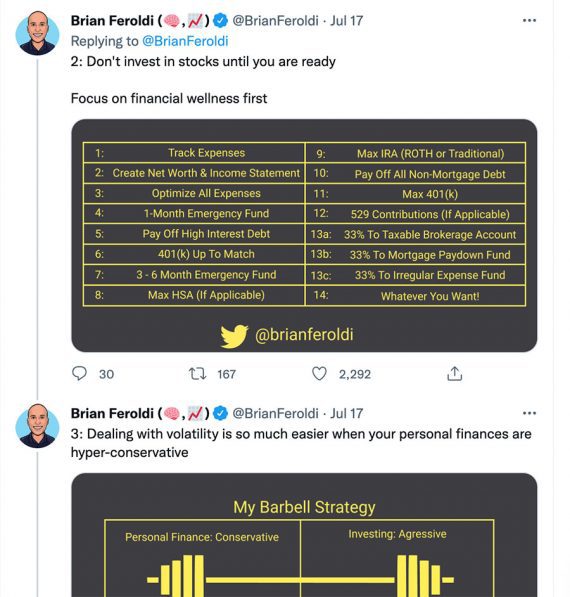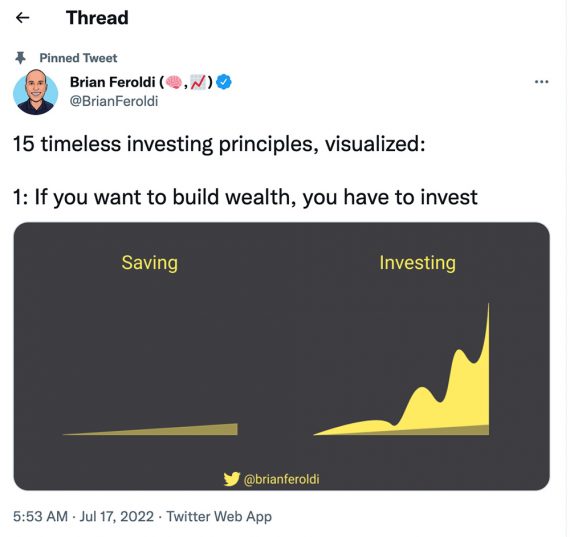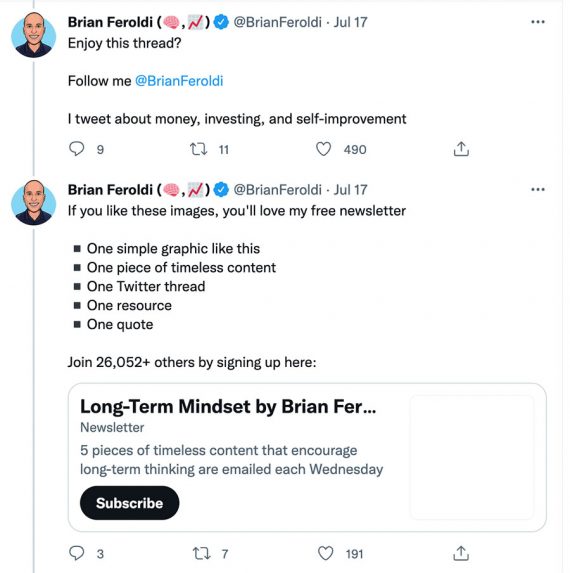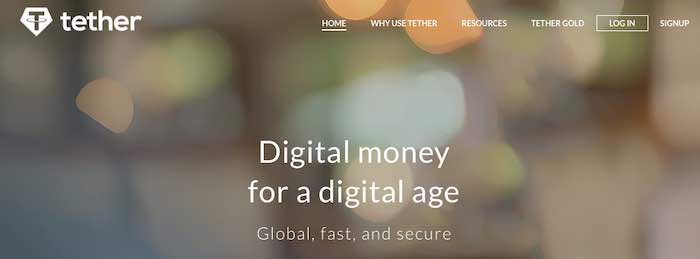Feroldi’s Twitter thread hook includes the topic, the first part of the body, and a custom graphic.
For Feroldi, a good Twitter thread has four parts:
Feroldi has a pinned thread on his Twitter profile. This thread is among his best performing, with more than 500 comments, 6,400 retweets, and 28,000 likes. The hook is both attention-grabbing and in keeping with Feroldi’s content generally, i.e., building wealth long term. It reads: “15 timeless investing principles, visualized: 1: If you want to build wealth, you have to invest.”

- The hook,
- The body,
- The ask,
- The summary.
The Hook



Finally, include a summary tweet at the end of the thread that pulls the series together, similar to the wrap-up in an article. In Feroldi’s thread, the summary tweet follows the ask, which follows tip 15.
Once the thread has provided value, it is time for the ask. The ask could be as simple as a call to action to subscribe to your newsletter or visit your website. It might request the reader to share the thread with her followers. Whatever the ask, make sure it is subdued, relevant, and easy to do.
The ask in a Twitter thread will depend on your marketing goals, but, like Feroldi, asking for more subscribers is common. Once someone is on your email list, it is much easier to pitch your products.
The Body
For many businesses, especially those in the so-called creator economy, Twitter is an excellent way to find like-minded colleagues, expand an audience, and make sales. I addressed that topic last week.
In the example from Feroldi, the ask is twofold. First, he asks people to follow him on Twitter. Then he asks them to subscribe to his newsletter. These are both relevant, given the content in the thread. They are also easy to do.

Feroldi’s ask tweet follows the 15 investment tips he had promised in the hook.
Take the same care in writing a thread as you would with your best articles or newsletters.
During a presentation at Fincon — a conference for financial coaches and authors — on September 10, 2022, entrepreneur Brian Feroldi described how he uses Twitter treads to grow and engage audiences. Feroldi, the founder of Long Term Mindset, an investing newsletter that goes out to 40,000 subscribers every Wednesday, has more than 358,000 Twitter followers.
While there are proven tactics for hook writing, Feroldi recommends reviewing its performance to guide your future tweets. If a thread performs well, document the hook’s topic, format, and image. For the latter, an image, Feroldi used a custom graphic that clearly communicates the difference between saving money and investing.
The Ask
The hook is the most important part of the thread. It entices people to click and read all tweets in the series. The hook is the equivalent of an email subject line or an article headline.
In the example thread from Feroldi, the promise in the hook is that the reader will see “15 timeless investing principles, visualized.” Hence the next 14 tweets in the thread should deliver on that promise. And, that’s what Feroldi provides, adding a tip and graphic in each subsequent tweet.

A Twitter thread is a series of connected tweets, a kind of short blog post to start a discussion or provide info. Threads are among the best ways to grow a following on Twitter.
The body of the thread contains your thoughts on the topic, the equivalent of the main text in an article. The body should provide value to the reader. It should be clear, concise, easy to follow, and deliver on whatever you promised in the hook.
The body of Feroldi’s Twitter thread fulfills the promise he made in the hook post.
The Summary
Do not assume that the body of a thread is unimportant or light on content. Feroldi estimated that he spends about five hours writing each thread. It’s serious content meant to deliver real value.

![[Infographic] Expert Opinion Round-Up: What Does GDPR Mean for Marketers?](https://research-institute.org/wp-content/uploads/2022/04/infographic-expert-opinion-round-up-what-does-gdpr-mean-for-marketers-768x576.jpg)




